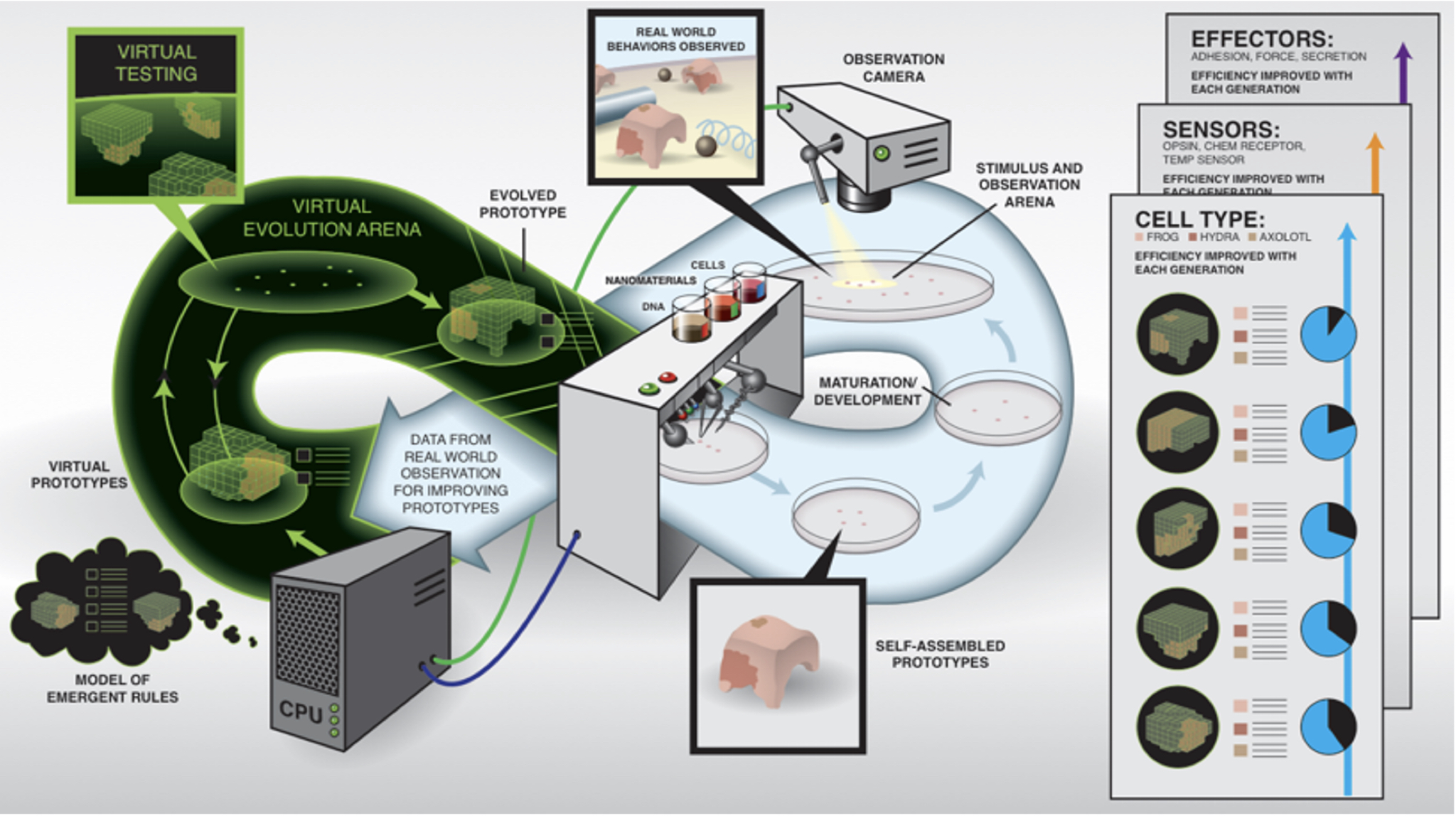
Biobot Science & Technology: Xenobots are living, swimming, self-powered naturally-biodegradable robots less than a millimeter across, evolved by artificial intelligence and built out of frog stem cells—and they could open new medical frontiers. These "biobots" are a new form of intelligence—and they’re changing the world. Biobots are actually assemblies of cells (cells from Xenopus Laevis in the case of Xenobots, though any cells could be used, in principle) that are designed to do useful work – sensing, processing, and acting upon their physical environment.
In 2020, Fauna Systems co-founders Michael Levin and Joshua Bongard produced a seminal paper with collaborators Sam Kriegman and Doug Blackiston showcasing the world’s first computer-designed living organism. Coverage in the New York Times called these tiny cell clusters, which could move and self-repair, “a new class of living robotics,” with the potential to profoundly change science, medicine and our understanding of life itself.
Sensing & Signal Amplification
→ Living cells already have a powerful array of sensing capabilities “built in” that can be extended with traditional synthetic biology circuitry.
→ Communication between bots can amplify a signal (“each tells two friends”).
Motility
→ Directed action: bots can follow gradients (e.g. pH, temperature, light, chemical, electrical)
Excretion, Sequestration
→ Biobots excretions can neutralize or modify targets of interest
→ Biobots or groups of biobots can in principle ingest or sequester targets of interest
Payload Delivery
→ Bots can carry payloads and/or emit useful chemicals when a target is discovered
→ Absorb, Metabolize lower species (molecules, viruses, bacteria)
→ Capture, Transport lower species (unicellular, low-cellular)
→ Assemble into larger Xenobots with different body shape and function
→ Assemble similar Xenobots from environment-borne cells (special cases)
→ Act as an interface between the micro-scale and the macro-scale
→ Clean a fish pond from bacteria without harming the fish with chemicals
→ Transform a microscopic signal into a macroscopic one via swarming
→ Store sequential memory of chemicals experienced during a voyage
→ Infect or transfect other animals or plants
→ Transfect other animals or plants
→ Reproduce without bounds
Might we be surrounded with undetected minds? (with Michael Levin) | Podcast
What is intelligence? If we look hard, can we find it in unexpected places: not just in brains but in all kinds of structures? How should we recognize it? And what does any of this have to do with a bipedal dog born without front legs, or making small new organisms out of single cells, or how Wikipedia might be like an axolotl, or why we are so blind to the vast variety of minds that might surround us?
Join Eagleman with guest Michael Levin, professor at Tufts, about how we might discover intelligence all around us in ways we don’t typically intuit.
Fauna Systems’ biobots are built on a foundation of rigorous academic research and are protected by a growing number of patents. Seminal papers include:
Blackiston, D., Lederer, E., Kriegman, S., Garnier, S., Bongard, J., and Levin, M., (2021), A cellular platform for the development of synthetic living machines, Science Robotics, 6(52): eabf1571, doi: 10.1126/scirobotics.abf1571
Bongard, J., and Levin, M., (2021), Living things are not (20th Century) machines: updating mechanism metaphors in light of the modern science of machine behavior, Frontiers in Ecology and Evolution, 9: 650726, doi: 10.3389/fevo.2021.650726
Kriegman, S., Blackiston, D., Levin, M., and Bongard, J., (2020), A scalable pipeline for designing reconfigurable organisms, Proceedings of the National Academy of Sciences of the United States, 117(4): 1853-1859
Levin, M., Bongard, J., and Lunshof, J.E, (2020), Applications and ethics of computer-designed organisms, Nature Reviews Molecular Cell Biology, 21: 655–656
Kriegman, S., Blackiston, D., Levin, M., & Bongard, J. (2021), Kinematic self-replication in reconfigurable organisms. Proceedings of the National Academy of Sciences, 118(49)
Davies, J., Levin, M. Synthetic morphology with agential materials. Nat Rev Bioeng 1, 46–59 (2023). https://doi.org/10.1038/s44222-022-00001-9
Levin M. Darwin's agential materials: evolutionary implications of multiscale competency in developmental biology. Cell Mol Life Sci. 2023 May 8;80(6):142. doi: 10.1007/s00018-023-04790-z. PMID: 37156924; PMCID: PMC10167196.
Biological Robots: Perspectives on an Emerging Interdisciplinary Field https://www.liebertpub.com/doi/pdf/10.1089/soro.2022.0142

Michael Levin
Co-Founder
Tufts University
is a developmental and synthetic biologist at Tufts University, where he is the Vannevar Bush Distinguished Professor. Levin is a director of the Allen Discovery Center at Tufts University. He is also co-director of the Institute for Computationally Designed Organisms with Josh Bongard.
AAAS Fellow, Vox 2024 Future Perfect Innovator, International Neural Network Society's Donald O. Hebb Award

Joshua Bongard
Co-Founder
University of Vermont
is a professor of Computer Science at the University of Vermont and a 2010 PECASE awardee. He is the co-author of the popular science books "How the Body Shapes the Way We Think: A New View of Intelligence", and "Designing Intelligence: Why Brains Aren't Enough". In 2007, he was named to the MIT Technology Review TR35 as one of the top 35 innovators in the world under the age of 35

Naimish Patel
CEO
Director
is an accomplished, passionate and dynamic technology executive with over 30 years of company-building and operating experience (Sycamore Networks, GridCo) and life sciences investing (at General Catalyst, Hyperplane Ventures, and as an angel). As CTO, Naimish propelled Sycamore Networks to IPO by shaping product strategy and architecture

Randy Castleman
Co-Founder Director
has 25 years of experience as an investor in emerging technologies. He is the Managing Partner of the Carbon Drawdown Collective, a single-family office focused on climate investing. He met Levin & Bongard while an EIR at the Wyss Institute for Biologically Inspired Engineering at Harvard University. He has a BA from Princeton and MBA from the University of Virginia.

Eugene Durenard
Co-Founder Director
is Founder and CEO of Hyperbolic Holdings, a Swiss-based investment holding and management company specialized in life sciences and healthcare innovation. He is co-founder of a few companies and serves on several executive and advisory boards. He has 25 years experience in investing and asset management and is the author of the book "Professional Automated Trading, Theory and Practice"